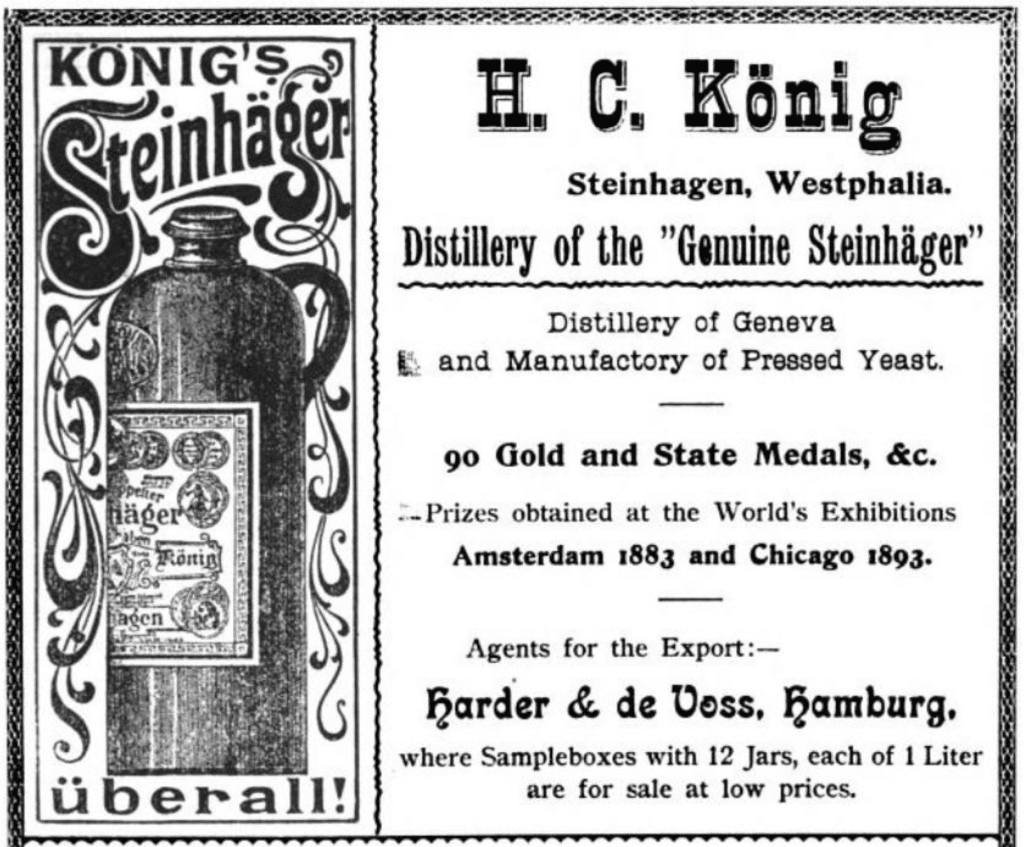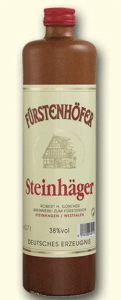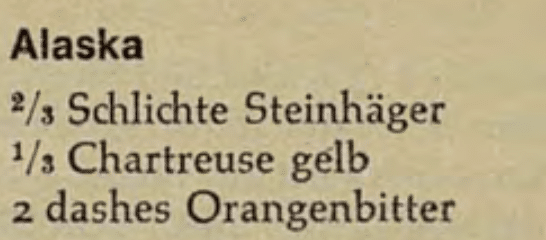Steinhäger is a protected Geographical Indication under European Union law. That means that spirits which bear the name must be follow a specific set of rules and be produced in the designated area. To maintain the designation, a technical file must be maintained that specifically calls out what makes that spirit distinct and different.
What is Steinhäger?
Firstly, while it is similar to gin— it is technically speaking its own thing. Legally it is classified as a Juniper-flavored spirit drink. This is especially confusing as the category’s most prominent brand, Schlichte, has put the words “Steinhaegar Dry Gin” on its bottles in English-speaking markets.
Steinhäger must be “clear,” with a “light to strong” aroma and flavor of “juniper.” No other ingredients, including colors or sweeteners, may be added.

Secondly, it must use Juniperus communis. The flavor must come exclusively from distillation. In other words you cannot have a compound Steinhäger.
Dried juniper berries are crushed, mixed with warm water, yeasts and then fermented for about two weeks. Afterwards, the juniper mash is distilled. A small amount of unfermented juniper may be added here and distilled. The resulting distillate should not have more than 15% ABV at this step.
For the next distillation, the juniper distillate is combined with grain distillate, and possibly more unfermented juniper berries. It once used to be required that the grain base be produced from locally grown wheat and rye; however, that is no longer mandated by law.
After blending and dilution, Steinhäger must have a minimum ABV of 38%. It then must be bottled in dark glass/stoneware bottles.
The place
The drink must be produced in the North Rhine/Westphalian community of Steinhagen. Located on the Southern slope of the Teutoberg Forest it’s located in a place that has also been called Ravensberg Land.
The region, for centuries, was a hub of farming. Juniperus communis is one of the species that was widely found growing wild on the rolling hills and forests of the region.

The history of Steinhäger
Similar to gin, Steinhäger has its origins in Renaissance medicinal culture. The production of a spirit drink in Steinhägen made from juniper can be traced back to at least the 15th century1.
Similar to other parts of Europe, German apothecaries often worked their cures around what was growing in the region. Juniper growing wild would have been easy to find and quite inexpensive. Because of its ubiquity in Europe, it’s no wonder that it became part of so many distinctive medicinal cultures.
At this time, Ravensberg Land was under Prussian rule. When the Great Elector visited, he was presented with a pitcher of Steinhäger. This marks a transition in its status. While initially developed as a home remedy, in this story, it’s more likely it was presented to the Elector as a recreational drink.
Despite it’s early roots, Steinhäger didn’t commercialize until much later. It’s not until the late 19th century that we see tens of distilleries in the region producing the spirit. Further, they were also beginning to be exported. Steinhägers won several medals at World’s Fairs during the 1800s and early 1900s.
As quickly as it rose to prominence, it declined. By 2000 only two distilleries producing it remained.


Is Steinhäger a gin?
Interestingly, the notion that it’s a complete separate things from gin seems to have evolved in rather recent history. It was often described as a “Geneva” and spirits called Steinhäger also won medals as a gin2.
While modern understanding of “gin” differentiates clearly between several varieties, including genever, gin, and others— for a long time all spirits with juniper were lumped under the heading gin.
While the addition of juniper berries to a spirit about to be redistilled sounds very gin like; the unusual base— which includes fermented juniper makes it distinctive and quite different. It’s perhaps more appropriate to link Steinhäger with other fermented juniper drinks like Borovicka than it is to call it a gin. Even though to simplify things, major brands like Schlichte have communicated it as if a gin, especially in English speaking markets.
Modern examples

Cocktails with Steinhager
888 Cocktails by Aladar v Wesendonk (1967) suggests the Alaska Cocktail be specifically made with Schlichte.

From Harry Schraemli’s Manuel du Bar (1965). Of every book I’ve seen, it has one of the most comprehensive treatment’s of the category during the last century

Footnotes
1 Von Herbert Schlichte, Das Branntweingewerbe in Steinhagen (1924)
2 International Exposition St. Louis 1904: Official Catalogue. Exhibition of the German Empire. (1904). Germany: G. Stilke.

Actually the real gin is flavoured only with juniper. If you read The Distillers Book, you will see the receipe for Geneva as being made of proof spirit, water and juniper berries. And is a natural thing. By his name gin tells is maked only from juniper. That thing bothered me all the time, that gin contains citrus, and flowers. I don’t wanna pay for them. In the worst case scenario I’ll choose something thats not London dry(does not have citrus). I was driven to a point once to make my own gin, to get rid of angelica, orris, cardamon, coriander & company.
“shall derive its main characteristic flavor from juniper berries and be bottled at not less than 80° proof.” is the current legal definition of gin. Gin is wide open, varied and a very fascinating spirit. I understand where you might be coming from in terms of what gin was early on considered to mean, or in fact whatever might be your personal preference [in that case, you might like Steinhager or the Master of Malt single origin gins]. There are gins out there which cater to your preference, but the “real gin” is in fact more varied than a single definition or source can really get at.
In 1969 I had the privilege of shooting with the German Army in Idar Oberstein. The soldiers took us to the Gasthouses and told us the Steinehager was the national drink of Germany and prepared the stomach for bier. It did. I drank it often after that and always with caution.
I went back to Germany in 2000 and could not find it but was prosted by an old couple when I asked for it. The bartender never heard of it. I was shocked and disappointed. A sad situation.
Germany, please remember your traditions!